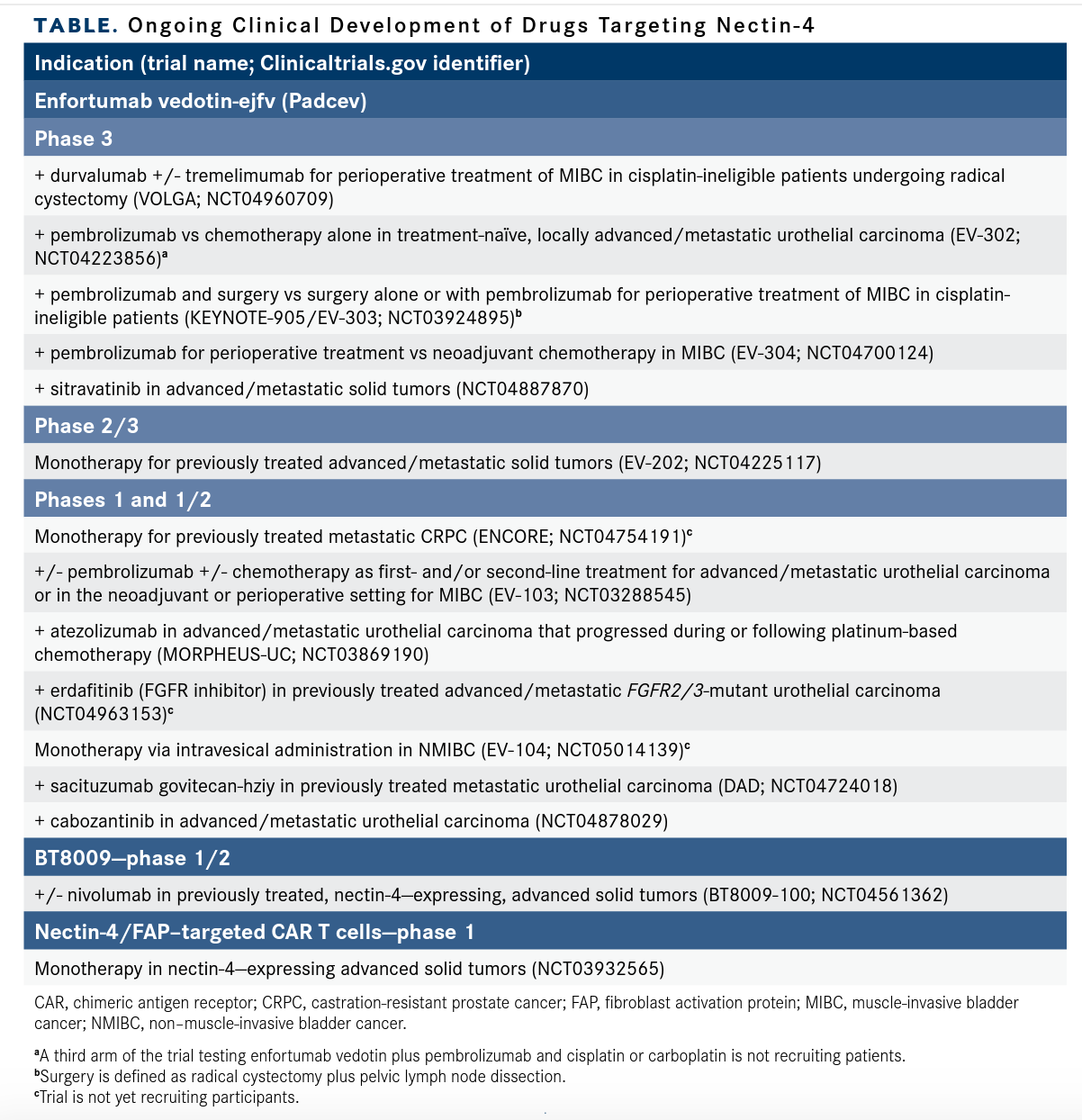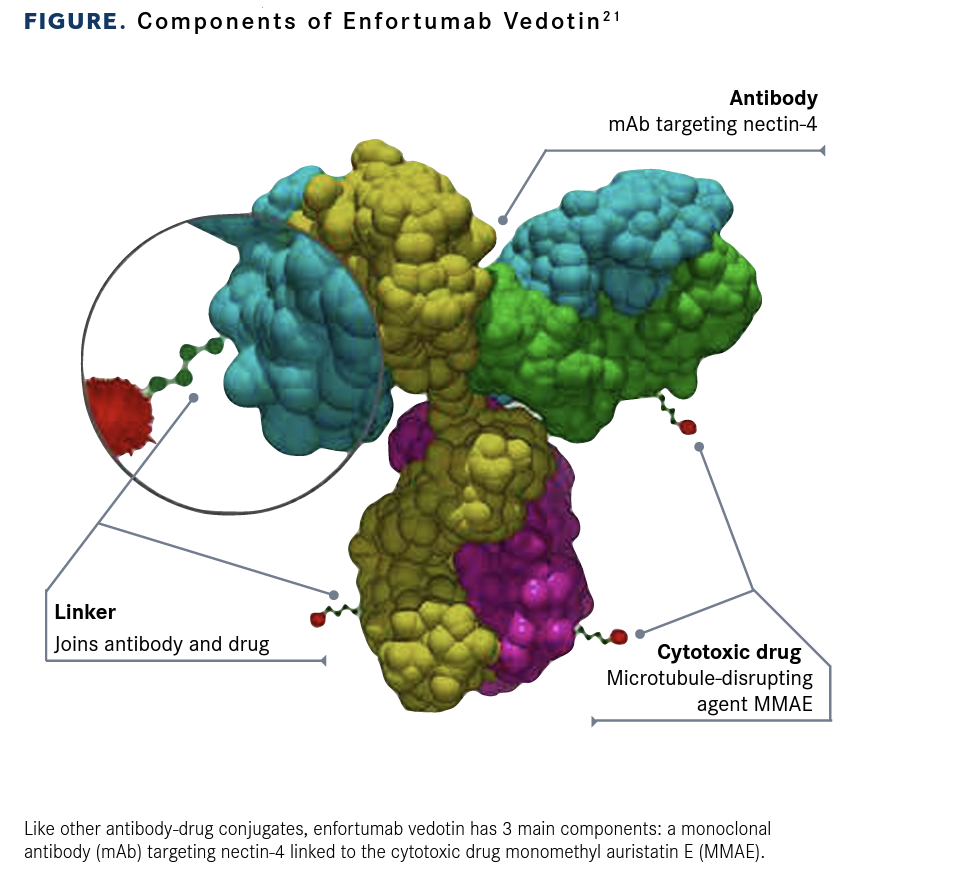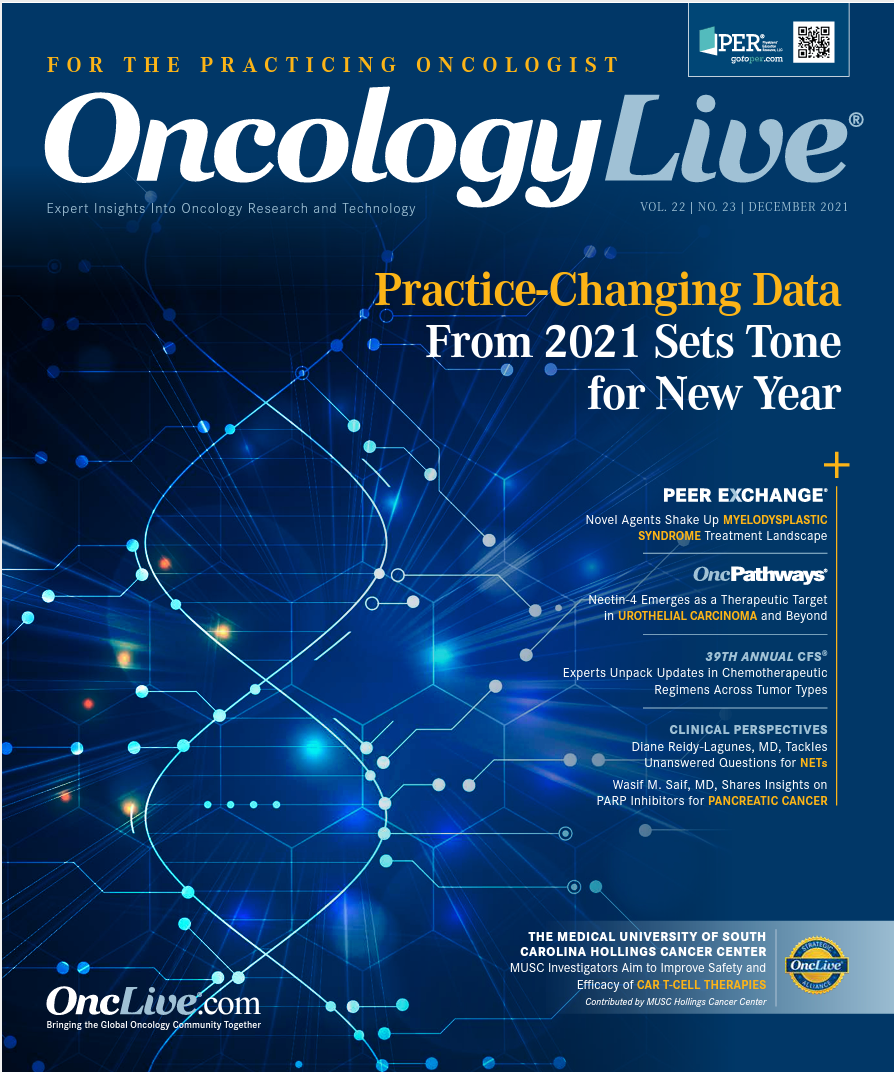Nectin-4 Emerges as a Therapeutic Target in Urothelial Carcinoma and Beyond
Most ongoing clinical trials exploring nectin-4 as a target involve studies of enfortumab vedotin and its potential synergy with immune checkpoint inhibitors in bladder cancer, while several other early-phase studies are testing novel agents in solid tumors.
In July 2021, the FDA granted full regulatory approval to enfortumab vedotin-ejfv (Padcev) for the treatment of patients with relapsed or refractory advanced/metastatic urothelial carcinoma.1 Previously awarded accelerated approval for this indication in 2019,2 enfortumab vedotin is the first drug to target the nectin-4 protein, a key regulator of cell adhesion.3,4
An antibody-drug conjugate (ADC), enfortumab vedotin exploits the high levels of nectin-4 expression in urothelial carcinoma to enable targeted deployment of a cytotoxic warhead in tumor cells.5 Specifically, enfortumab vedotin is approved for patients with locally advanced/metastatic urothelial carcinoma who have been previously treated with a PD-1/PD-L1 immune checkpoint inhibitor (ICI) and platinum-containing chemotherapy or are ineligible for cisplatin-containing chemotherapy after receiving 1 or more prior lines of therapy.1
Beyond enfortumab vedotin, the devel-opment of nectin-4–targeted drugs is in its infancy; other agents are in the preclinical or very early clinical stages of development. However, burgeoning interest in this target reflects the potential oncogenic role of nectin-4 across a broad range of malignancies.5,6
Furthermore, there is growing appreciation of the role of nectins in the antitumor immune response through their interaction with immune checkpoint receptors, including TIGIT (T-cell immunoreceptor with immunoglobulin and ITIM domains).5,7
Most ongoing clinical trials exploring nectin-4 as a target involve studies of enfortumab vedotin and its potential synergy with ICIs in bladder cancer, while several other early-phase studies are testing novel agents in solid tumors (Table). Meanwhile, agonistic nectin-4–specific monoclonal antibodies could have ICI functionality in their own right.8
Table. Ongoing Clinical Development of Drugs Targeting Nectin-4

An Ideal Target
The nectin family of proteins, whose name derives from the Latin necto, meaning “to connect,” are cell adhesion molecules that are essential to forming physical connections between neighboring cells to enable intercellular communication, migration, and other vital cellular processes.3-5
Among the 4 human nectin proteins, nectin-4 is unique in that its expression is largely restricted to placental and embryonic tissues. Importantly, however, in contrast to healthy adult tissue, many types of cancer have high nectin-4 expression.5,6
In urothelial carcinoma, moderate to high levels of nectin-4 were observed in 60% of bladder cancer samples in 1 study9 and in 34% of upper tract urothelial carcinoma samples in another.10 In upper tract urothelial carcinoma, high levels of nectin-4 were associated with a significantly higher risk of progression (P = .03) and cancer-specific mortality (P = .04) and were an independent predictor of disease progression in high-risk disease (HR, 3.32; 95% CI, 1.20-7.98; P = .03).10
Other cancer types in which nectin-4 overexpression has been found in a significant portion of samples include breast, ovarian, cervical, colorectal, esophageal, gastric, lung, liver, and thyroid cancer. Studies have suggested that nectin-4 expression may predict poor prognosis in several types of cancer; however, its analytical and clinical validity have not been fully established and its clinical utility as a prognostic marker remains to be confirmed.5,6
High nectin-4 expression is associated with increased tumor size, grade, and invasiveness, as well as reduced patient survival, in some cancer types. In addition, nectin-4 overexpression may be linked to chemotherapy resistance.5,11-19 A recent study also demonstrated that nectin-4 expression was upregulated in BRAF inhibitor–resistant melanoma cells.20
As a result of its cancer-specific expression, nectin-4 has emerged as a highly promising therapeutic target. The main focus of drug development has been in advanced/metastatic urothelial carcinoma, in which 5-year survival rates are abysmally low despite the availability of novel immunotherapeutic options.6,21
The standard of care for patients with advanced/metastatic urothelial carcinoma is platinum-based chemotherapy; however, a substantial number of patients are ineligible for chemotherapy. Patients with recurrent disease or whose tumors express PD-L1 may be treated with ICIs, but only a minority of patients experience durable responses; response rates are particularly low among patients with visceral metastases.6,21
Filling a Niche in Bladder Cancer
Enfortumab vedotin, formerly ASG-22CE, is an ADC composed of a nectin-4–targeted monoclonal antibody conjugated via a cleavable linker to a microtubule-disrupting cytotoxic drug, monomethyl auristatin E (MMAE). It exploits nectin-4 expression in urothelial carcinoma to target the delivery of MMAE to tumor cells (Figure21). Once the nectin-4 antibody component of the drug binds to nectin-4 on the membrane, the ADC is taken up into the cell, and the linker is cleaved within the lysosome, releasing MMAE, which binds to tubulin, disrupting microtubule assembly and driving cell cycle arrest and apoptosis.5,6,21
Figure. Components of Enfortumab Vedotin

Accelerated approval of enfortumab vedotin for the treatment of locally advanced/ metastatic urothelial carcinoma in 20192 was based largely on the results of 2 clinical trials, EV-101 and EV-201.21 EV-101 (NCT02091999) was a phase 1 dose-escalation and dose-expansion study of enfortumab vedotin in patients with previously treated advanced/metastatic solid tumors.22
Initially, trial eligibility requirements included positive tumor nectin-4 expression per immunohistochemistry (IHC) analysis; however, the protocol was amended to remove this criterion after nectin-4 expression was identified in almost all samples (median IHC H-score, 290; range, 0-300). In cohort A, patients were treated with enfortumab vedotin monotherapy at escalating doses up to 1.25 mg/kg on days 1, 8, and 15 of 28-day cycles. In cohort B, dose expansion was performed in 3 patient populations: those with urothelial carcinoma, non–small cell lung cancer, or ovarian cancer. Cohort C involved dose expansion in patients with metastatic urothelial carcinoma that had progressed following ICI therapy.22
Among the 112 patients with metastatic urothelial carcinoma who were treated with enfortumab vedotin at 1.25 mg/kg, the overall response rate (ORR) was 43% (95% CI, 33.6%-52.6%), with a median duration of response (DOR) of 7.4 months (95% CI, 5.6-9.6) and median overall survival (OS) of 12.3 months (95% CI, 9.3-15.3). Similar response rates were observed across all patient subgroups, including patients aged 75 years or older, those with liver metastases, and those with upper tract disease. The most common treatment-related adverse events (TRAEs) were rash, peripheral neuropathy, fatigue, alopecia, and nausea, predominantly grade 1 or 2 in severity.22
EV-201 (NCT03219333) was a phase 2 single-arm trial in which enfortumab vedotin was tested in patients with metastatic urothelial carcinoma who had been previously treated with both platinum-based chemotherapy and ICIs (cohort 1) or with an ICI only (cohort 2). Patients were treated with a dose of 1.25 mg/kg on days 1, 8, and 15 of 28-day cycles. Although nectin-4 positivity was not a requirement for enrollment, nectin-4 expression (median IHC H score, 290; range, 14-300) was identified in 100% of the 120 patient samples that were collected.23
In cohort 1 (n = 125), the ORR was 44% (95% CI, 35.1%-53.2%), including complete responses (CRs) in 12% of patients, with a median DOR of 7.6 months (95% CI, 4.93-7.46). Similar ORRs were observed across prespecified patient subgroups, including patients with liver metastases. The most common TRAEs were fatigue, alopecia, decreased appetite, dysgeusia, and peripheral neuropathy.23 Results from cohort 2 (n = 89) were also recently published; at a median follow-up of 13.4 months, the ORR was 52% (95% CI, 41%-62%), with CRs in 20% of patients.24
Full Approval Secured
Continued approval of enfortumab vedotin was premised on the demonstration of confirmed efficacy in randomized phase 3 trials. In the phase 3 EV-301 trial (NCT03474107), enfortumab vedotin was compared with standard chemotherapy in patients (n = 608) with locally advanced or metastatic urothelial carcinoma previously treated with platinum-based chemotherapy and an ICI. Patients were randomized 1:1 to enfortumab vedotin at a dose of 1.25 mg/kg on days 1, 8, and 15 of 28-day cycles or investigator’s choice of chemotherapy (docetaxel; n = 117, paclitaxel; n = 112, or vinflunine [where approved for use]; n = 78) administered on day 1 of 21-day cycles.25
At a median follow-up of 11.1 months, enfortumab vedotin was found to significantly improve OS and progression-free survival (PFS) compared with chemotherapy in this patient population, reducing the risk of death by 30% and the risk of progression or death by 38%. Median OS was 12.88 months (95% CI, 10.58-15.21) in the enfortumab vedotin arm compared with 8.97 months (95% CI, 8.05-10.74) in the chemotherapy arm (HR, 0.70; 95% CI, 0.56-0.89; P = .001), and median PFS was 5.55 months (95% CI, 5.32-5.82) vs 3.71 months (95% CI, 3.52-3.94), which translated into an HR of 0.62 (95% CI, 0.51-0.75; P < .001). Patients treated with enfortumab vedotin also had a significantly higher ORR (40.6% vs 17.9%; P < .001) and a numerically higher CR rate (4.9% vs 2.7%).25
The incidence of TRAEs of any grade (93.9% vs 91.8%) or of grade 3 and higher (51.4% vs 49.8%), as well as the rates of dose reduction, interruption, and discontinuation resulting from TRAEs, were similar in the 2 study arms. The most common grade 3 and higher TRAEs experienced by patients treated with enfortumab vedotin were maculopapular rash, fatigue, decreased neutrophil count, and neutropenia.25
In an update presented at the European Society for Medical Oncology Congress 2021, findings showed that the survival benefit associated with enfortumab vedotin treatment was maintained across hard-to-treat patient subgroups, including patients aged 65 years and older and those with liver metastases, upper tract disease, and lack of response to prior ICI therapy.26
In numerous ongoing clinical trials, investigators are evaluating the potential of enfortumab vedotin in the frontline setting for patients with advanced/metastatic urothelial carcinoma (EV-302; NCT04223856), as well as earlier in the course of disease in the perioperative setting (VOLGA; NCT04960709 and EV-304; NCT04700124).
Results from a cohort of patients enrolled in the ongoing EV-103 trial (NCT03288545) were recently published. EV-103 is a phase 1/2 trial evaluating enfortumab vedotin as monotherapy or in combination with other cancer drugs as first- and second-line treatment for patients with advanced/metastatic disease. After more than 2 years of follow-up, 45 cisplatin-ineligible patients who were treated with the combination of enfortumab vedotin and the PD-1 ICI pembrolizumab (Keytruda), in the frontline setting had an ORR of 73.3% (95% CI, 58.1%85.4%), including CRs in 17.8% of patients, with a median DOR of 25.6 months (95% CI, 8.3-not reached) and median PFS of 12.3 months (95% CI, 8.0-not reached). Among patients with liver metastases, the ORR was 57.1%. The most common TRAEs were peripheral neuropathy, fatigue, and alopecia.27,28
On the basis of these results, this combination was granted a breakthrough therapy designation by the FDA for the frontline treatment of patients with cisplatin-ineligible metastatic urothelial carcinoma.6,29
An Immunomodulatory Role
An increasingly recognized aspect of nectin family members is their role in immune modulation. Several nectins and nectin-like (Necl) molecules act as ligands for costimulatory and coinhibitory immune checkpoint receptors, and in recent years, the nectin family banner has been widened to encompass these receptors, most notably TIGIT.7
TIGIT, a coinhibitory immune checkpoint receptor expressed on the surface of multiple immune cell types, exerts an immunosuppressive function. Alongside the costimulatory receptor CD226, TIGIT forms an immune checkpoint pathway that is analogous to the prototypical CD28/CTLA-4 checkpoint pathway. The ligands for TIGIT include CD112 (also known as nectin-2) and CD155 (Necl-5).7,30
TIGIT has emerged as a promising target for the next generation of ICIs. Several TIGIT-targeted drugs are in clinical development, including Roche’s tiragolumab (MTIG719A) and Merck’s vibostolimab (MK-7684).7 A recent study identif ied nectin-4 as a novel ligand for TIGIT. Unlike other TIGIT ligands, which bind to additional receptors, nectin-4 appears to exclusively bind to TIGIT; this interaction was shown to inhibit the activity of natural killer cells.8
Thus, in addition to providing specificity in tumor targeting, nectin-4–targeted therapies could also prove to have immunotherapeutic properties. The vast majority of ongoing clinical trials of enfortumab vedotin and development of novel nectin-4–targeted therapies are focusing on combining these drugs with ICIs in the hopes of eliciting synergistic activity.
Agents in development include Bicycle Therapeutics’ BT8009, whose design is similar to an ADC. The agent is conjugated to an MMAE but uses the company’s proprietary bicyclic peptides instead of an antibody to target nectin-4. Investigators hypothesize that the more rapid plasma clearance achieved by the small bicyclic peptide will reduce BT8009’s systemic toxicity compared with bulkier antibody-based agents.31
Jane de Lartigue, PhD, is a freelance medical writer based in Gainesville, Florida.
References
- FDA grants regular approval to enfortumab vedotin-ejfv for locally advanced or metastatic urothelial cancer. FDA. Updated July 9, 2021. Accessed October 8, 2021. https://www.fda.gov/drugs/resources-information-approved-drugs/fda-grants-regular-approval-enfortumab-vedotin-ejfv-locally-advanced-or-metastatic-urothelial-cancer
- FDA grants accelerated approval to enfortumab vedotin-ejfv for metastatic urothelial cancer. FDA. Updated December 19, 2019. Accessed October 13, 2021. https://www.fda.gov/drugs/resources-information-approved-drugs/fda-grants-accelerated-approval-enfortumab-vedotin-ejfv-metastatic-urothelial-cancer
- Miyoshi J, Takai Y. Nectin and nectin-like molecules: biology and pathology. Am J Nephrol. 2007;27(6):590-604. doi:10.1159/000108103
- Samanta D, Almo SC. Nectin family of cell-adhesion molecules: structural and molecular aspects of function and specificity. Cell Mol Life Sci. 2015;72(4):645-658. doi:10.1007/s00018-014-1763-4
- Chatterjee S, Sinha S, Kundu CN. Nectin cell adhesion molecule-4 (NECTIN-4): a potential target for cancer therapy. Eur J Pharmacol. 2021;911:174516. doi:10.1016/j.ejphar.2021.174516
- Heath EI, Rosenberg JE. The biology and rationale of targeting nectin-4 in urothelial carcinoma. Nat Rev Urol. 2021;18(2):93-103. doi:10.1038/s41585-020-00394-5
- Johnston RJ, Lee PS, Strop P, Smyth MJ. Cancer immunotherapy and the nectin family. Ann Rev Cancer Biol. 2021;5:203-219. doi:10.1146/annurev-cancerbio-060920-084910
- Reches A, Ophir Y, Stein N, et al. Nectin4 is a novel TIGIT ligand which combines checkpoint inhibition and tumor specificity. J Immunother Cancer. 2020;8(1). doi:10.1136/jitc-2019-000266
- Challita-Eid PM, Satpayev D, Yang P, et al. Enfortumab vedotin antibody–drug conjugate targeting nectin-4 is a highly potent therapeutic agent in multiple preclinical cancer models. Cancer Res. 2016;76(10):3003-3013. doi:10.1158/0008-5472.CAN-15-1313
- Tomiyama E, Fujita K, Rodriguez Pena MDC, et al. Expression of nectin-4 and PD-L1 in upper tract urothelial carcinoma. Int J Mol Sci. 2020;21(15):5390. doi:10.3390/ijms21155390
- Fabre-Lafay S, Monville F, Garrido-Urbani S, et al. Nectin-4 is a new histological and serological tumor associated marker for breast cancer. BMC Cancer. 2007;7:73. doi:10.1186/1471-2407-7-73
- Athanassiadou AM, Patsouris E, Tsipis A, Gonidi M, Athanassiadou P. The significance of Survivin and Nectin-4 expression in the prognosis of breast carcinoma. Folia Histochem Cytobiol. 2011;49(1):26-33. doi:10.5603/FHC.2011.0005
- M-Rabet M, Cabaud O, Josselin E, et al. Nectin-4: a new prognostic biomarker for efficient therapeutic targeting of primary and metastatic triple-negative breast cancer. Ann Oncol. 2017;28(4):769-776. doi:10.1093/annonc/mdw678
- Bekos C, Muqaku B, Dekan S, et al. NECTIN4 (PVRL4) as putative therapeutic target for a specific subtype of high grade serous ovarian cancer—an integrative multi-omics approach. Cancers (Basel). 2019;11(5):698. doi:10.3390/cancers11050698
- Nabih ES, Abdel Motaleb FI, Salama FA. The diagnostic efficacy of nectin 4 expression in ovarian cancer patients. Biomarkers. 2014;19(6):498-504. doi:10.3109/1354750X.2014.940503
- Takano A, Ishikawa N, Nishino R, et al. Identification of nectin-4 oncoprotein as a diagnostic and therapeutic target for lung cancer. Cancer Res. 2009;69(16):6694-6703. doi:10.1158/0008-5472.CAN-09-0016
- Nayak A, Das S, Nayak D, Sethy C, Narayan S, Kundu CN. Nanoquinacrine sensitizes 5-FU-resistant cervical cancer stem-like cells by down-regulating nectin-4 via ADAM-17 mediated NOTCH deregulation. Cell Oncol (Dordr). 2019;42(2):157-171. doi:10.1007/s13402-018-0417-1
- Deng H, Shi H, Chen L, Zhou Y, Jiang J. Over-expression of nectin-4 promotes progression of esophageal cancer and correlates with poor prognosis of the patients. Cancer Cell Int. 2019;19:106. doi:10.1186/s12935-019-0824-z
- Lin X, Hu H, Pan Y, Gao S. The prognostic role of expression of nectin-4 in esophageal cancer. Med Sci Monit. 2019;25:10089-10094. doi:10.12659/MSM.918288
- Tanaka Y, Murata M, Shen C-H, Furue M, Ito T. Nectin4: a novel therapeutic target for melanoma. Int J Mol Sci. 2021;22(2):976. doi:10.3390/ijms22020976
- Halford Z, Anderson MK, Clark MD. Enfortumab vedotin-ejfv: a first-in-class anti–nectin-4 antibody-drug conjugate for the management of urothelial carcinoma. Ann Pharmacother. 2021;55(6):772-782. doi:10.1177/1060028020960402
- Rosenberg J, Sridhar SS, Zhang J, et al. EV-101: a phase I study of single-agent enfortumab vedotin in patients with nectin-4-positive solid tumors, including metastatic urothelial carcinoma. J Clin Oncol. 2020;38(10):1041-1049. doi:10.1200/JCO.19.02044
- Rosenberg JE, O’Donnell PH, Balar AV, et al. Pivotal trial of enfortumab vedotin in urothelial carcinoma after platinum and anti-programmed death 1/programmed death ligand 1 therapy. J Clin Oncol. 2019;37(29):2592-2600. doi:10.1200/JCO.19.01140
- Yu EY, Petrylak DP, O’Donnell PH, et al. Enfortumab vedotin after PD-1 or PD-L1 inhibitors in cisplatin-ineligible patients with advanced urothelial carcinoma (EV‑201): a multicentre, single-arm, phase 2 trial. Lancet Oncol. 2021;22(6):872-882. doi:10.1016/S1470-2045(21)00094-2
- Powles T, Rosenberg JE, Sonpavde GP, et al. Enfortumab vedotin in previously treated advanced urothelial carcinoma. N Engl J Med. 2021;384(12):1125-1135. doi:10.1056/NEJMoa2035807
- Rosenberg JE, Powles T, Sonpavde GP, et al. Analysis of hard-to-treat subgroups from EV-301: a phase III trial of enfortumab vedotin (EV) vs chemotherapy for previously treated advanced urothelial carcinoma. Ann Oncol. 2021;32(suppl 5):S710-S711. doi:10.1016/j.annonc.2021.08.094
- Friedlander TW, Milowsky MI, Bilen MA, et al. Study EV-103: update on durability results and long term outcome of enfortumab vedotin + pembrolizumab in first line locally advanced or metastatic urothelial carcinoma (la/mUC). J Clin Oncol. 2021;39(suppl 15):4528. doi:10.1200/JCO.2021.39.15_suppl.4528
- Rosenberg JE, Flaig TW, Friedlander TW, et al. Study EV-103: preliminary durability results of enfortumab vedotin plus pembrolizumab for locally advanced or metastatic urothelial carcinoma. J Clin Oncol. 2020;38(suppl 6):441. doi:10.1200/JCO.2020.38.6_suppl.441
- Astellas and Seattle Genetics receive FDA breakthrough therapy designation for Padcev (enfortumab vedotin-ejfv) in combination with pembrolizumab in first-line advanced bladder cancer. News release. Astellas Pharma Inc; February 20, 2020. Accessed October 12, 2021. https://www.astellas.com/en/news/15601
- Chauvin JM, Zarour HM. TIGIT in cancer immunotherapy. J Immunother Cancer. 2020;8(2):e000957. doi:10.1136/jitc-2020-000957
- Rigby M, Beswick P, Mudd G, et al. Abstract 4479: BT8009: a bicyclic peptide toxin conjugate targeting nectin-4 (PVRL4) displays efficacy in preclinical tumor models. Cancer Res. 2019;79(suppl 13):4479. doi:10.1158/1538-7445.AM2019-4479




